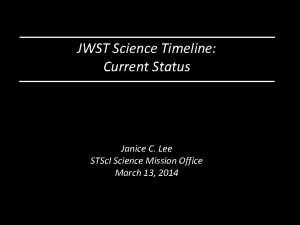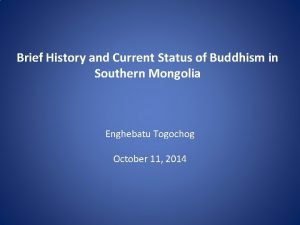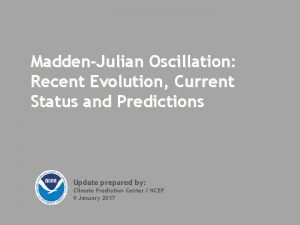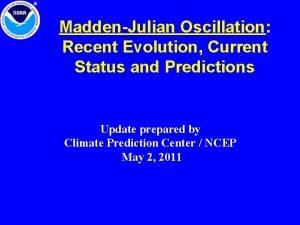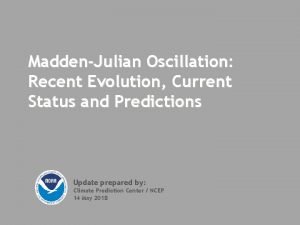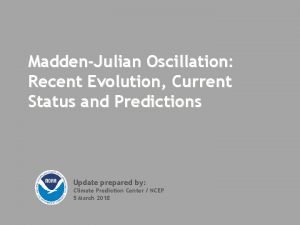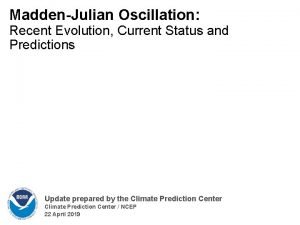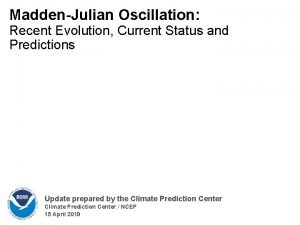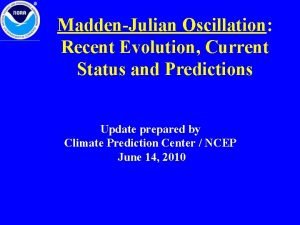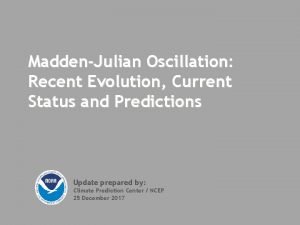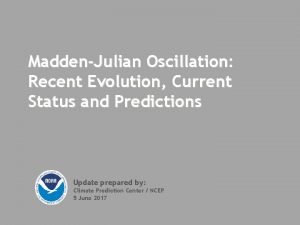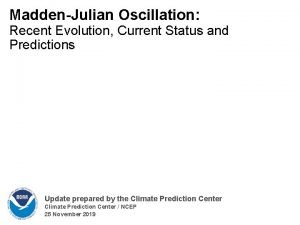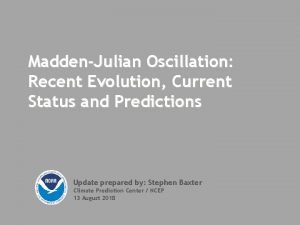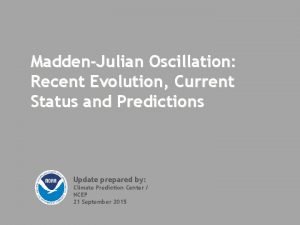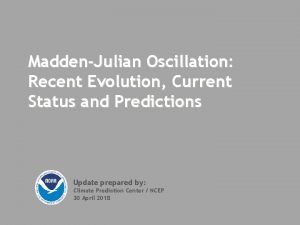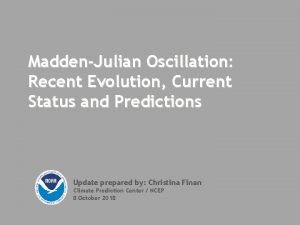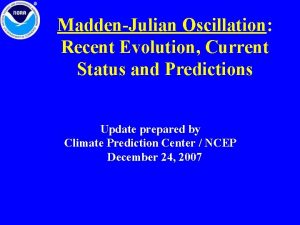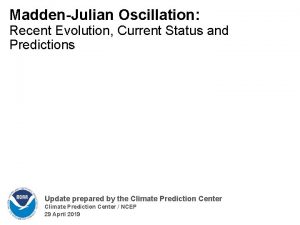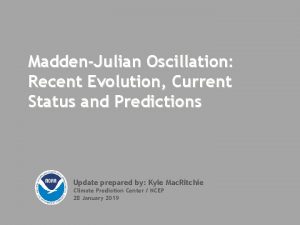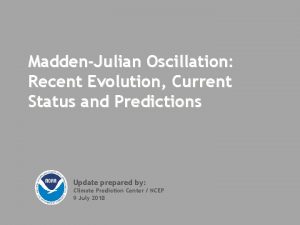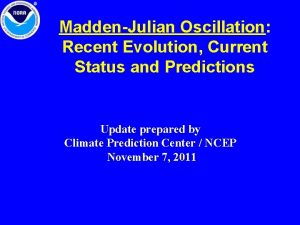MaddenJulian Oscillation Recent Evolution Current Status and Predictions





















- Slides: 21

Madden-Julian Oscillation: Recent Evolution, Current Status and Predictions Update prepared by Climate Prediction Center / NCEP March 05, 2012

Outline • Overview • Recent Evolution and Current Conditions • MJO Index Information • MJO Index Forecasts • MJO Composites

Overview • The MJO remained active during the past week with the enhanced phase shifting across the eastern Indian Ocean. • Dynamical model MJO index forecasts show a moderate strength MJO signal continuing through the period. There is some spread amongst the models about the magnitude and phase by the end of Week-2, but most favor the enhanced phase moving across the Maritime Continent during the period. The MJO is forecast to remain active during the upcoming 1 -2 weeks. • The MJO is forecast to contribute to enhanced convection across the Maritime Continent and parts of the western Pacific during the next two weeks. Suppressed convection is favored for the parts of Brazil, Africa, and the Indian Ocean (Weeks 1 -2) during the period. • The current and upcoming phases of the MJO favor constructive interference with La Nina conditions for the majority of the period as enhanced convection related to the MJO increases over the Maritime continent. • Above-average temperatures are favored for the eastern U. S. as the MJO enhanced phase shifts across the Maritime continent into the western Pacific. The MJO and La Nina favor enhanced moisture across parts of the Pacific Northwest, the northern tier of the contiguous U. S, Great Lakes and Ohio Valley. Additional potential impacts across the global tropics are available at: http: //www. cpc. ncep. noaa. gov/products/precip/CWlink/ghazards/index. php

850 -h. Pa Vector Wind Anomalies (m s-1) Note that shading denotes the zonal wind anomaly Blue shades: Easterly anomalies Red shades: Westerly anomalies over the Atlantic Ocean and Africa expanded eastward and increased during the past five days. Easterly anomalies persisted over the Maritime Continent and expanded over the Central Pacific during the past five days. Westerly wind anomalies over the eastern Pacific Ocean persisted during the last five days.

850 -h. Pa Zonal Wind Anomalies (m s-1) Westerly anomalies (orange/red shading) represent anomalous west-to-east flow Easterly anomalies (blue shading) represent anomalous east-to-west flow In early October, MJO activity weakened the persistent easterly anomalies across the central Pacific (first dashed line). Time MJO activity continued into December (altering dashed and dotted lines), but then westerly (easterly) wind anomalies across the Indian Ocean (western Pacific) became more stationary. In early February, westerly anomalies extended to 140 E and were associated with the current MJO activity. Longitude Recently, easterly anomalies expanded westward over the Maritime Continent and Western Pacific while westerly anomalies persisted over the eastern Pacific.

OLR Anomalies – Past 30 days Drier-than-normal conditions, positive OLR anomalies (yellow/red shading) Wetter-than-normal conditions, negative OLR anomalies (blue shading) During late January and early February, suppressed convection was observed in the central Pacific, Africa and the western Indian Ocean. Enhanced convection covered the area from the eastern Maritime continent to the southwest Pacific. The MJO contributed to enhanced convection across the Americas and the Atlantic during early-to-mid February. Suppressed convection was observed for the eastern Indian Ocean and northern Australia. During late February, the MJO contributed to enhanced (suppressed) convection across Africa and the Indian Ocean (western Pacific).

Outgoing Longwave Radiation (OLR) Anomalies (7. 5°S-7. 5°N) Drier-than-normal conditions, positive OLR anomalies (yellow/red shading) Wetter-than-normal conditions, negative OLR anomalies (blue shading) (Courtesy of CAWCR Australia Bureau of Meteorology) Beginning in mid-September, enhanced convection shifted from southern Asia to the western Pacific while suppressed convection developed during late September across India and also shifted eastward to the western Pacific. Time MJO activity continued into early December, then OLR anomalies decreased and eastward propagation was not as clear. Enhanced convection (dashed lines) propagated eastward across the Indian Ocean and Maritime Continent during January as the MJO strengthened. MJO activity has continued into March. Other modes of coherent subseasonal tropical variability (Equatorial Rossby Wave) is also evident during February between 80 E and 140 E. Longitude

200 -h. Pa Velocity Potential Anomalies (5°S-5°N) Positive anomalies (brown shading) indicate unfavorable conditions for precipitation Negative anomalies (green shading) indicate favorable conditions for precipitation Beginning in the second half of September into December, alternating negative (dashed lines) and positive (dotted lines) anomalies were evident and associated with MJO activity during the period. Time Eastward propagation of anomalies became less coherent during late December and early January and anomalies weakened. Eastward propagation again became evident in late January and continued to mid February, during which anomalies became nearly stationary. In the most recent couple of days, eastward propagation is once again more evident. Longitude

IR Temperatures (K) / 200 -h. Pa Velocity Potential Anomalies Positive anomalies (brown contours) indicate unfavorable conditions for precipitation Negative anomalies (green contours) indicate favorable conditions for precipitation The large scale velocity potential pattern generally exhibits a wave-1 structure with upperlevel divergence across the Indian Ocean and Maritime Continent, with upper-level convergence from the central Pacific to western Africa. Other modes of subseasonal tropical variability and mid-latitude influences are also affecting the pattern.

200 -h. Pa Vector Wind Anomalies (m s-1) Note that shading denotes the zonal wind anomaly Blue shades: Easterly anomalies Red shades: Westerly anomalies C A large scale cyclonic circulation is evident north of the equator east of the Date Line with a more elongated trough south of the equator. C C During the most recent five days, westerly anomalies over the western and central Pacific have increased in coverage and magnitude while easterly anomalies have spread over equatorial Africa. The entire upper-level pattern over the Pacific has shifted slowly westward.

200 -h. Pa Zonal Wind Anomalies (m s-1) Westerly anomalies (orange/red shading) represent anomalous west-toeast flow Easterly anomalies (blue shading) represent anomalous east-to-west flow Alternating westerly (dashed lines) and easterly (dotted lines) anomalies are evident from mid-September into December associated with the MJO. Time In December, westerly anomalies strengthened over the Pacific. In January these westerly anomalies have shown some eastward propagation and easterly anomalies have also shifted eastward into the Pacific. During February, westerly anomalies have moved slowly westward and are now located over the Maritime Continent and the Western Pacific. Longitude

Weekly Heat Content Evolution in the Equatorial Pacific An oceanic Kelvin wave (dashed line) shifted eastward during February and March 2011. Since late July, negative heat content anomalies are evident across the equatorial central and eastern Pacific. Time In January and February 2012, negative heat content anomalies have weakened in the central and eastern equatorial Pacific. Longitude

MJO Index -- Information • The MJO index illustrated on the next several slides is the CPC version of the Wheeler and Hendon index (2004, hereafter WH 2004). Wheeler M. and H. Hendon, 2004: An All-Season Real-Time Multivariate MJO Index: Development of an Index for Monitoring and Prediction, Monthly Weather Review, 132, 1917 -1932. • The methodology is very similar to that described in WH 2004 but does not include the linear removal of ENSO variability associated with a sea surface temperature index. The methodology is consistent with that outlined by the U. S. CLIVAR MJO Working Group. Gottschalck et al. 2010: A Framework for Assessing Operational Madden-Julian Oscillation Forecasts: A CLIVAR MJO Working Group Project, Bull. Amer. Met. Soc. , 91, 1247 -1258. • The index is based on a combined Empirical Orthogonal Function (EOF) analysis using fields of near-equatorially-averaged 850 -h. Pa and 200 -h. Pa zonal wind and outgoing longwave radiation (OLR).

MJO Index -- Recent Evolution § The axes (RMM 1 and RMM 2) represent daily values of the principal components from the two leading modes § The triangular areas indicate the location of the enhanced phase of the MJO § Counter-clockwise motion is indicative of eastward propagation. Large dot most recent observation. § Distance from the origin is proportional to MJO strength § Line colors distinguish different months The MJO index shows continued MJO activity during the past week. The eastward propagation has returned to speeds consistent with coherent MJO activity.

MJO Index – Historical Daily Time Series Time series of daily MJO index amplitude from 1997 to present. Plots put current MJO activity in historical context.

Ensemble GFS (GEFS) MJO Forecast Yellow Lines – 20 Individual Members Green Line – Ensemble Mean RMM 1 and RMM 2 values for the most recent 40 days and forecasts from the ensemble Global Forecast System (GEFS) for the next 15 days light gray shading: 90% of forecasts dark gray shading: 50% of forecasts The ensemble GFS forecasts the MJO signal to continue propagating eastward over the next two weeks with the enhanced phase over the Maritime Continent during Week-1 and potentially entering the Western Pacific by the end of Week-2.

Ensemble Mean GFS MJO Forecast Figures below show MJO associated OLR anomalies only (reconstructed from RMM 1 and RMM 2) and do not include contributions from other modes (i. e. , ENSO, monsoons, etc. ) Spatial map of OLR anomalies for the next 15 days The ensemble mean GFS forecast indicates enhanced convection across the Indian Ocean and Maritime Continent during Week-1 with some eastward propagation into the western Pacific by the end of Week-2. Suppressed convection is forecast across the central equatorial Pacific and the lower latitudes of the Americas during the period. Time-longitude section of (7. 5°S-7. 5°N) OLR anomalies for the last 180 days and for the next 15 days

Constructed Analog (CA) MJO Forecast Figure below shows MJO associated OLR anomalies only (reconstructed from RMM 1 and RMM 2) and do not include contributions from other modes (i. e. , ENSO, monsoons, etc. ) Spatial map of OLR anomalies for the next 15 days The CA forecast shows enhanced convection stretching from the Indian Ocean to the Maritime Continent during Week-1, and later the western Pacific during Week-2. A return to drier than average conditions across Africa and the Indian Ocean is forecast during Week-2. Time-longitude section of (7. 5°S-7. 5°N) OLR anomalies for the last 180 days and for the next 15 days

MJO Composites – Global Tropics 850 -h. Pa Wind Anomalies (Nov-Mar) Precipitation Anomalies (Nov-Mar)

U. S. MJO Composites – Temperature § Left hand side plots show temperature anomalies by MJO phase for MJO events that have occurred over the three month period in the historical record. Blue (orange) shades show negative (positive) anomalies respectively. § Right hand side plots show a measure of significance for the left hand side anomalies. Dark blue and purple shades indicate areas in which the anomalies are significant at the 95% or better confidence level. Zhou et al. (2011): A composite study of the MJO influence on the surface air temperature and precipitation over the Continental United States, Climate Dynamics, 1 -13, doi: 10. 1007/s 00382 -0111001 -9 http: //www. cpc. ncep. noaa. gov/products/precip/CWlink/MJO/mjo. shtml

U. S. MJO Composites – Precipitation § Left hand side plots show precipitation anomalies by MJO phase for MJO events that have occurred over the three month period in the historical record. Brown (green) shades show negative (positive) anomalies respectively. § Right hand side plots show a measure of significance for the left hand side anomalies. Dark blue and purple shades indicate areas in which the anomalies are significant at the 95% or better confidence level. Zhou et al. (2011): A composite study of the MJO influence on the surface air temperature and precipitation over the Continental United States, Climate Dynamics, 1 -13, doi: 10. 1007/s 00382 -0111001 -9 http: //www. cpc. ncep. noaa. gov/products/precip/CWlink/MJO/mjo. shtml
 Y connected generator
Y connected generator Line vs phase voltage
Line vs phase voltage Drift current and diffusion current in semiconductor
Drift current and diffusion current in semiconductor Lesson 4 three-phase motors
Lesson 4 three-phase motors Drift current
Drift current What is diffusion current and drift current
What is diffusion current and drift current Balanced delta-delta connection
Balanced delta-delta connection Infineon
Infineon Diffusion current density
Diffusion current density Application of size separation
Application of size separation The constant current region of a jfet lies between
The constant current region of a jfet lies between Chapter 3 shielded metal arc welding
Chapter 3 shielded metal arc welding Hazard based safety engineering
Hazard based safety engineering Mesh current method with current source
Mesh current method with current source Current program status register is
Current program status register is Jwst commissioning timeline
Jwst commissioning timeline Current status of buddhism
Current status of buddhism What is mean by periodic motion
What is mean by periodic motion Indication and contraindication of mobilization
Indication and contraindication of mobilization Passive angular stretching
Passive angular stretching Dynamics
Dynamics Graded oscillation technique
Graded oscillation technique















